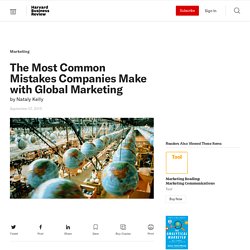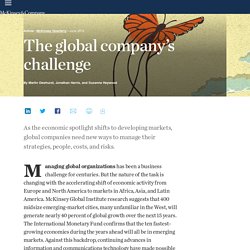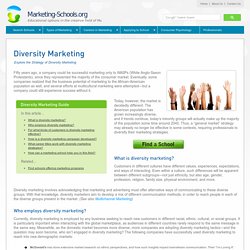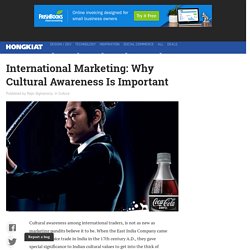

Globalization and new strategies for growth - The world is bumpy. Overall average scores for globalization Source: Globalization Index 2011.

Amazon. The Most Common Mistakes Companies Make with Global Marketing. Marketers often find themselves at the forefront of a company’s global expansion.

The marketing team is usually responsible for carrying out the market research that will determine where a company should expand, and it’s usually charged with creating a plan for attracting customers. As a former business consultant to marketing executives at companies trying to expand globally, I’ve noticed some common marketing roadblocks that can stand in the way of international success: 1. Not specifying countries. Executives tend to think about overseas markets in vague regional terms (e.g., “We’re shifting our focus to Asia,” or “We’d like to double our growth in Europe”), but this oversimplification is problematic. It’s essential to break up broader geographic “markets” into individual countries with distinct revenue and lead generation goals—and to conduct adequate local market research.
The global company’s challenge. As the economic spotlight shifts to developing markets, global companies need new ways to manage their strategies, people, costs, and risks.

Managing global organizations has been a business challenge for centuries. But the nature of the task is changing with the accelerating shift of economic activity from Europe and North America to markets in Africa, Asia, and Latin America. McKinsey Global Institute research suggests that 400 midsize emerging-market cities, many unfamiliar in the West, will generate nearly 40 percent of global growth over the next 15 years. The International Monetary Fund confirms that the ten fastest-growing economies during the years ahead will all be in emerging markets. Against this backdrop, continuing advances in information and communications technology have made possible new forms of international coordination within global companies and potential new ways for them to flourish in these fast-growing markets. There are individual success stories. Winning in a polycentric world: globalization and the changing world of business - 4. Diverse leadership teams. Summary: Increasingly, homogenous management teams made up of individuals who have spent their entire career at corporate headquarters will no longer be fit for purpose.

Instead, companies need to ensure that management teams comprise individuals from diverse backgrounds and different ages, races and gender, who have experience of both fast-and slow-growth markets. What is Diversity Marketing? Explore the Strategy of Diversity Marketing Fifty years ago, a company could be successful marketing only to WASPs (White Anglo-Saxon Protestants), since they represented the majority of the consumer market.

Eventually, some companies realized that the business potential of marketing to the African-American population as well, and several efforts at multicultural marketing were attempted—but a company could still experience success without it. Today, however, the market is decidedly different. The American population has grown increasingly diverse, and if trends continue, today’s minority groups will actually make up the majority of the population some time around 2040. Thus, a “general market” strategy may already no longer be effective in some contexts, requiring professionals to diversify their marketing strategies. Understand Your Customers for Global Marketing Success. Five New Challenges For Tomorrow's Global Marketing Leaders. This article is by Chris Bolman, director of growth at Percolate.

In a global world, brands need to speak a lot of different customers’ languages. And, as mobile, social and software increasingly break down traditional communications borders to transform how brands communicate with consumers, marketing leaders are facing new strategic challenges as they look to develop global marketing fluency. 1. The Convergence of Brand and Customer Today, every customer is a multichannel customer and every employee is a steward of your brand’s story and culture. International Expansion by New Venture Firms: International Diversity, Mode of Market Entry, Technological Learning, and Performance. International Marketing: Why Cultural Awareness Is Important. Cultural awareness among international traders, is not as new as marketing pundits believe it to be.

When the East India Company came and began spice trade in India in the 17th century A.D., they gave special significance to Indian cultural values to get into the thick of things. But competition, perhaps, was not particularly stiff at that point of time, although early traders are aware of the potential it has in their trading strategy. Nowadays, companies that are going global with their products have to contend with local companies who are armed with vast knowledge on how the locals react to a certain cultural pulse.
They had also established their presence much earlier – they were there first. Thus, the newcomers must make sure that their products and promotional techniques are sensitive to cultural values of the people to leave a good impression of their branding. Recommended Reading: How To Design Websites That Communicate Across Cultures Crossing the barriers. Case Study: Coca Cola’s Successful Cross-Cultural Marketing Campaigns. Getting your desired message across to more than one group of people, or to a demographic consisting of diverse cultures can pose a challenge.

Many acts of cross cultural marketing have failed, such as the marketing 101 tale of the Chevrolet Nova, whose sales tanked in Spanish speaking countries because “No va,” means “doesn’t go” in Spanish. Issues like this highlight the importance of having a trustworthy and native speaking translation service. One company is particularly talented at crossing cultural boundaries, and corporations can learn some helpful strategies from their efforts. In 2013, Coca Cola aired a heartfelt commercial. The ad spot featured actors singing the Patriotic tune “America the Beautiful” in 7 different languages.